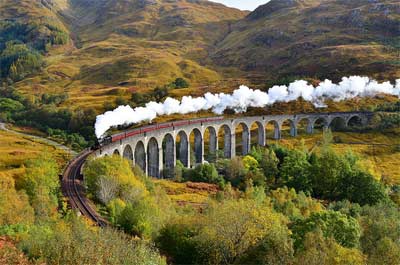Visit Scotland
Scotland is not just the land of Braveheart, haggis, and sheep herders. It is filled with castles, stunning lochs and mountains, beautiful parks, and welcoming locals.
In Scotland, there are so many options for visitors: city, countryside, Highland, Lowland, islands, must sees and hidden gems. We will be working hard on growing this section and sharing lots of advice and stories from our own experience.
Travel and Getting Around Scotland
Scotland is a small country and travel is easy. There are direct air links with UK cities, with Europe and North America. There is also an internal air net work bringing the islands of the North and West within easy reach.
Scotland ‘s rail network not only includes excellent cross- border InterCity services but also a good internal network. Travelling Britain by rail has never been easier. Choose from the many Britrail Passes or other products that are on offer.
By Train
All major towns are linked by rail and there are also links to the western seaboard at Mallaig and Kyle of Lochalsh (for ferry connections to Skye and the western isles) and to Inverness, Thurso and Wick for ferries to Orkney and Shetland.

The Jacobite Steam Train – Described as one of the great train journeys in the world. This goes from Fort William to Mallaig

Ferry from Ullapool to Lewis
By Boat
Ferries to and around the islands are regular and reliable, most ferries carry vehicles, although some travelling to smaller islands carry only passengers.
Contact the Information Department, Scottish Tourist Board. PO Box 705, Edinburgh EH4 3EU. or any Tourist information centre for details of travel and transport.
Many visitors choose to see Scotland by road – distances are short and driving on the quiet roads of the Highlands is a new and different experience. In remoter areas, some roads are still single track, and passing place must be used. When vehicles approach from different directions, the car nearest to a passing place must stop in or opposite it. Please do not use passing places to park in!
By Car
Speed limits on Scottish roads: Dual carriageways 70mph/112kph; single carriageways 60mph/96kph ; built up areas 30mph/48kph.
The driver and front seat passenger in a car must wear seatbelts, rear seatbelts if fitted, must be used. Small children and babies must at all times be restrained in a child seat or carrier.
Weather
Average temperatures in the summertime in most parts of Scotland are around 55/65F so pack clothes which are appropriate for that range. The temperatures can fall below this but equally they can be above, so it is best to have clothes which you can ‘layer’ and add and subtract as required. Temperatures above 80F are most unusual in Scotland.
Average rainfall in Edinburgh is around 26 inches – about 2.5 inches a month.
There can be a lot of cloud around even when it is not raining. Despite modern forecasting, rainfall can be unpredictable, so it is usually safer to take a waterproof coat or umbrella.
Rainfall is higher in the west than in the east – Glasgow has an average of 46 inches of rain and some exposed places have even higher levels.
If you are in the Highlands and climbing in the hills, don’t forget it gets colder higher up – and that weather can change rapidly, even in summer.
Winters temperatures in central Scotland are usually in the range 30/45F and the wind chill factor in winter can make it feel colder, especially in the East. So if you are coming over for New Year (Hogmanay) wrap up warm.
Snow is not very frequent in central Scotland – you need to go further north and into the mountains and even there, snow for the ski resorts is not guaranteed.
In an average year, there are around 1,500 hours of sunshine in central Scotland – so bring your sunglasses too! . If you want to reduce the amount of rain you experience, the driest months of the year are April and May
Top Things to See and Do
Popular Places in Scotland
Edinburgh
Glasgow
Isle of Skye
Inverness
Aberdeen
Oban
Dundee
Fort William
Dunfermline
Island of Mull
Ayr
Ullapool
Stirling
Stornoway
Dumfries
Leith
Loch Lomond
Inveraray
Perth
Pitlochry
Aviemore
Paisley
Lerwick
North Berwick
Islay
Fraserburgh
Stonehaven
Falkirk
Banff
Loch Ness
Durness
Musselburgh
Applecross
Saint Andrews
Callander
Melrose
Arrochar
Turriff
John O’Groats
Fair Isle
South Uist
Plockton
Kelso
Moffat
Langholm
Lanark
Aberfeldy
Falkland
Dornie
Kilmartin
Iona
Glenelg
Tobermory
Stromness
Linlithgow
Arbroath
Kirkwall
Gairloch
Kilmarnock
Peebles
Gatehouse of Fleet
Annan
Portree
Kingussie
Loch Katrine
Lewis
Telephone Codes
If you are calling from abroad, first dial your own country’s international access code ( usually 00,but do please check ). Next, dial the UK code 44, then the area code except for the first 0, then the remainder of the number as normal.
What time of the year is best for travelling to Scotland?
Spring in Scotland
Spring is probably the best season in Scotland weather wise. Usually, by May the weather settles down and you can spend some excellent days outdoors. The temperature in May is not too bad but long sleeved shirts or tops are mandatory.
Summer in Scotland
The summer is Scotland’s most unpredictable and temperamental season You can get anything from rainy days without an end to smashing sunny days. It just depends on luck. The first time around when i went to Scotland I spent 4 weeks out of which I had to spend one indoors because of pouring rain. The second time around however, in 7 weeks I had only a handful of pouring days of which the one I remember best is the day I went to Stirling and from 10 am when I set foot in Stirling to 6 PM when I left to Edinburgh I got soaked to the skin (needless to say I was caught off guard and had no umbrella).
Autumn in Scotland
If Scotland’s green is at its greenest in the summer, autumn is also a delight for the traveller’s eyes The colour of the grass begins to change, so does that of leaves. Everything (and especially the Highlands) seem depicted in true colours. Also, the autumn light is warmer and if you are into photography you can get some lovely pictures.
Winter in Scotland
Winters is Scotland are cold but hardly snowing, not in Central and South Scotland anyway. Although few people prefer to travel to Scotland in winter time, one can still enjoy the rough, but majestic Scottish Highlands covered in snow.
Opening times for Scottish tourist attractions
Unfortunately, most historic buildings, castles and so on are not open all year long. They are usually open most of the year except late autumn, all of winter and perhaps early spring. It might be an idea to check with Historic Scotland and National Trust for Scotland or opening times for tourist attractions in various parts of Scotland.
Other relevant Sections
Making the most out of visiting your Ancestral Land
Dr Bruce Durie advises on starting your search for Scottish ancestry.
Exciting time! You have booked your ancestral tour, got your travel tickets and headed for the airport. But how much preparation did you do before booking? Not just packing, but having all the information at your fingertips to really make the best of your experience.
There’s no question that anyone who comes to Scotland has a good time. The culture, the stunning scenery, the visitor-friendly towns and cities, the welcoming inhabitants, the food and drink and even (most of the time!) the weather – they all add up to an unbeatable experience. And yet, many visitors say it could have been so much better if they had thought a bit more deeply about what they wanted to achieve.
find out more …
Ancestral Tours
Let Jamie, Lord Sempill, take you on one of his stunning tours. Or have Jamie Sempill and Bruce Durie build a bespoke tour based on your personal ancestry. Have your next Family Reunion in your Scottish Ancestral heartlands, with expert guides and personalised research opportunities.
Take a look at some of the Ancestral tours >>
Attend a Highland Games
Scotland’s Highland games date back almost a thousand years. Held across the country from May to September, this national tradition is said to stem from the earliest days of the clan system.
Go to Highland Games >>
 Clan Map of Scotland
Clan Map of Scotland
Clan map of Scotland showing Scottish clans and their territories.
View map >>
What you can and can not wear and display
Attending a Clan or Family Gathering? Want to get it right? Well aware that feathers may be ruffled and noses out-jointed, Dr Bruce Durie, Shenachie to the Chief of Durie, offers this straightforward guide.
Read guide >>









